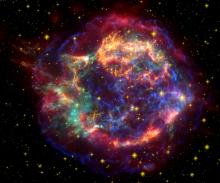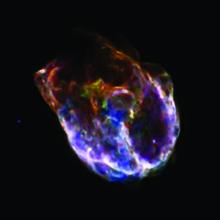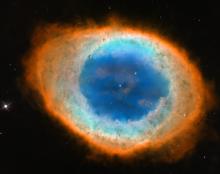Listen to today's episode of StarDate on the web the same day it airs in high-quality streaming audio without any extra ads or announcements. Choose a $8 one-month pass, or listen every day for a year for just $30.
You are here
Moon and Spica
In the final day of its life, the core of a massive star is a busy factory. It churns out new chemical elements at an incredible rate. And when that day ends, the star explodes. That scatters some of the newly formed elements into space, where they might someday be incorporated into new stars and planets.
All stars create energy by “fusing” lighter elements to make heavier ones. Stars that are at least eight times the mass of the Sun produce a larger variety of elements.
Near the end of that process, a layer around the star’s core has been converted to silicon. Over the final day, the silicon stages complicated reactions that produce sulfur, calcium, titanium, iron, and others.
Most of those elements take part in the nuclear reactions. But not iron. It takes more energy than the star can produce for the iron to fuse together to make still-heavier elements. So the star stops producing energy. Its core collapses, and its outer layers are blasted into space. For a brief time, the explosion produces enough energy to make even more elements.
Such stars are the source of the iron, silicon, and many other elements found here on Earth — elements forged in the stars.
One star that’ll be making those elements appears near the Moon the next couple of mornings. Spica will stand below the Moon tomorrow, and to the right of the Moon the next day. Spica is massive enough to end its life as a supernova — and spew a bounty of elements into the universe.
Script by Damond Benningfield





